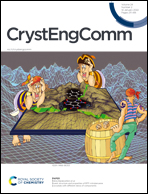Stable isomeric layered indium coordination polymers for high proton conduction†
Abstract
Coordination polymers have received immense attention for proton conduction owing to their highly tunable and designable structures. Herein, based on the flexible ligand 5-(4-pyridine)-methoxyisophthalic acid (H2L), two novel highly chemically stable indium coordination polymers (In-CPs), InL(H2O)Cl·H2O (In–L–Cl) and InL(H2O)(NO3) (In–L–NO3), were synthesized through solvothermal methods. In–L–Cl and In–L–NO3 are isostructural, in which every individual In(III) atom connects to L2− to form a single layer, and coordinated Cl− and NO3− are inserted into the windows of the interlayers. Both of them possess high water and chemical stability. More importantly, the abundant Cl− and NO3− exposed in the interlayer can act as hydrogen bond acceptors to facilitate the formation of a dense hydrogen bonding network, thus improving proton transfer efficiently. Electrochemical impedance spectroscopy shows that In–L–Cl and In–L–NO3 display optimized proton conductivities of 1.88 × 10−3 and 1.00 × 10−3 S cm−1 at 100% relative humidity (RH) and 80 °C, respectively. The difference in proton conductivity of In–L–Cl and In–L–NO3 likely stems from the variations in the hydrogen bonding networks formed by lattice water and the different electronegativities of the coordinated anionic functional sites. This study provides an alternative way to prepare highly proton-conductive CPs.



 Please wait while we load your content...
Please wait while we load your content...